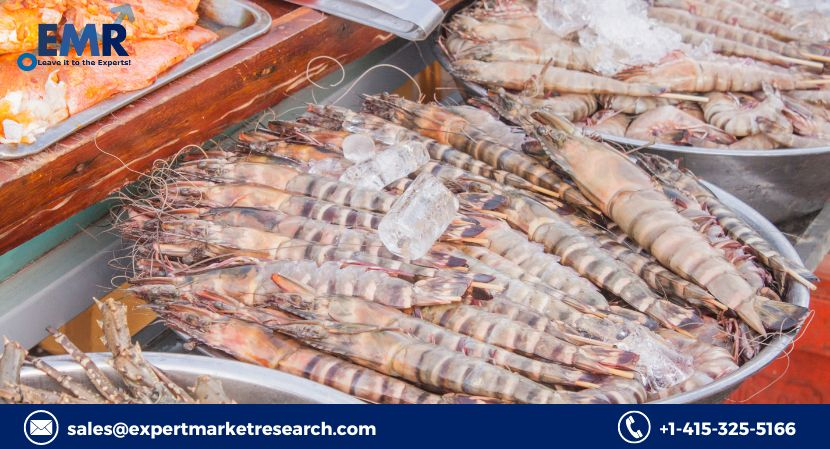The global shrimp market size has experienced substantial growth, reaching a volume of 8.08 million tons in 2024. Shrimp's popularity as a high-protein, low-fat food rich in essential nutrients—such as vitamins, minerals, and omega-3 fatty acids—has made it a key component of healthy diets worldwide. The market is expected to continue its upward trajectory, growing at a compound annual growth rate (CAGR) of 6.30% from 2025 to 2034. By the end of this forecast period, the market volume could reach 14.88 million tons. This blog explores the market dynamics, key growth drivers, emerging trends, challenges, and segmentation to provide a comprehensive understanding of the shrimp industry's future.
Key Drivers Fueling Market Growth
1. Rising Demand for High-Protein, Low-Fat Foods: Consumers are increasingly seeking nutritious food options that align with healthy lifestyle choices. Shrimp, being rich in protein and low in fat, meets this demand. Its omega-3 fatty acid content also contributes to cardiovascular health, boosting its appeal among health-conscious consumers.
2. Growth in Seafood Consumption Worldwide: The global appetite for seafood continues to rise, driven by shifting dietary preferences, urbanisation, and increased awareness of the health benefits of seafood. Shrimp, being versatile and widely available, remains one of the most popular seafood items.
3. Adoption of Environmentally Friendly Shrimp Farming Practices: The industry is shifting towards sustainable and eco-friendly farming methods, such as recirculating aquaculture systems (RAS) and biofloc technology. These practices help reduce environmental impact and meet the growing consumer demand for sustainably sourced seafood.
4. Expanding Global Trade and Export Opportunities: Shrimp is a highly traded commodity, with countries like India, Vietnam, and Ecuador leading in exports. The expansion of global trade agreements and the reduction of trade barriers are further facilitating the growth of the shrimp market.
Challenges Facing the Market
1. Environmental Concerns and Regulatory Hurdles: Despite efforts to promote sustainable farming, traditional shrimp farming methods still contribute to environmental degradation, including mangrove deforestation and water pollution. Stricter environmental regulations could impact production processes and increase costs.
2. Disease Outbreaks in Shrimp Farming: Shrimp farming is susceptible to diseases like Early Mortality Syndrome (EMS) and White Spot Syndrome Virus (WSSV), which can devastate shrimp populations and disrupt supply chains. Managing disease outbreaks remains a significant challenge for producers.
3. Fluctuating Feed and Production Costs: Feed represents a major cost in shrimp farming, and fluctuations in feed prices can affect profitability. Additionally, rising labour and operational costs can strain smaller producers.
4. Supply Chain Disruptions: Global supply chains remain vulnerable to disruptions caused by factors such as geopolitical tensions, pandemics, and natural disasters. These disruptions can impact the availability and pricing of shrimp in key markets.
Emerging Trends in the Shrimp Market
1. Rise of Organic and Eco-Certified Shrimp Products: Consumers are increasingly prioritising sustainability and transparency in their food choices. The demand for organic and eco-certified shrimp is growing, prompting producers to adopt environmentally friendly farming methods and obtain relevant certifications.
2. Growth of Value-Added Shrimp Products: The market for value-added shrimp products, such as pre-cooked, marinated, and ready-to-eat options, is expanding. These convenient products cater to busy consumers seeking quick, healthy meal solutions.
3. Technological Advancements in Aquaculture: Innovations in shrimp farming technology, including automation, water quality monitoring systems, and advanced feed formulations, are improving productivity and sustainability. These advancements help reduce environmental impact and increase yield.
4. Expansion of E-Commerce and Direct-to-Consumer Sales: The rise of e-commerce platforms has made it easier for consumers to purchase fresh and frozen shrimp directly from producers. This trend is reshaping traditional distribution channels and expanding market reach.
Market Segmentation
1. By Type:
-
Cold Water Shrimp: Found in colder regions, these shrimp are prized for their delicate flavour and firm texture.
-
Warm Water Shrimp: Cultivated primarily in tropical regions, warm water shrimp are the most widely consumed type, known for their versatility and affordability.
2. By Form:
-
Fresh/Chilled: Preferred in markets with strong demand for fresh seafood, such as Europe and North America.
-
Frozen: The most common form, offering longer shelf life and easier transportation.
-
Canned: A convenient option for ready-to-eat meals and widely used in processed foods.
3. By Distribution Channel:
-
Supermarkets and Hypermarkets: The primary retail channels for shrimp, offering a wide variety of fresh, frozen, and processed options.
-
Specialty Stores: Focused on high-quality, sustainably sourced seafood products.
-
Online Retail: E-commerce platforms are becoming increasingly popular, offering convenient home delivery options.
-
Food Service: Restaurants, hotels, and catering services represent a significant portion of shrimp consumption, especially in urban areas.
4. By End-User:
-
Household Consumption: Driven by the growing demand for nutritious, home-cooked meals.
-
Commercial Use: Includes restaurants, catering businesses, and food processors that rely on shrimp for a variety of dishes and products.
Regional Insights
1. Asia-Pacific: Asia-Pacific dominates the global shrimp market, both in production and consumption. Countries like India, Vietnam, Thailand, and Indonesia are leading producers and exporters, while China and Japan are significant consumers. The region's strong aquaculture infrastructure and favourable climate contribute to its market leadership.
2. North America: The United States is a major importer of shrimp, with high consumer demand for both fresh and frozen products. The region's growing interest in sustainable seafood is driving the demand for eco-certified shrimp.
3. Europe: Europe is a key market for premium and sustainably sourced shrimp products. Countries like Spain, France, and the UK are significant consumers, with increasing demand for organic and eco-friendly options.
4. Latin America: Latin American countries, particularly Ecuador and Argentina, are prominent players in shrimp production and export. The region's shrimp industry is expanding due to growing global demand and investments in sustainable aquaculture practices.
Future Opportunities
1. Expansion of Sustainable Shrimp Farming: As consumers and regulators prioritise sustainability, there is significant potential for growth in eco-friendly and organic shrimp farming. Producers adopting sustainable practices can tap into premium markets and build brand loyalty.
2. Development of Innovative Shrimp Products: The rise of value-added and ready-to-eat shrimp products presents opportunities for product innovation. Companies can explore new flavours, packaging formats, and convenience-oriented products to attract diverse consumer segments.
3. Investment in Aquaculture Technology: Technological advancements, such as automated feeding systems, water quality sensors, and disease monitoring tools, can enhance efficiency and sustainability in shrimp farming. Investing in these technologies can improve productivity and reduce operational costs.
4. Expansion into Emerging Markets: Rising disposable incomes and changing dietary habits in emerging markets, particularly in Africa and Southeast Asia, present opportunities for market expansion. Producers can capitalise on growing demand by offering affordable and high-quality shrimp products.

